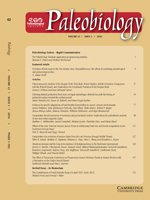It has generally been argued that the majority of fossil benthic foraminifera, the most common proxy for paleo bottom oceanic conditions, could not tolerate anoxia. Here we present evidence that fossil foraminifera were able to successfully colonize anoxic-dysoxic bottom waters, by using adaptations similar to those found in living species. Our study is based on a multi proxy micropaleontological and geochemical investigation of the Upper Cretaceous sediments from the Levant upwelling regime. A shift from buliminid to diverse trochospiral dominated assemblages was recorded in an interval with a distinct anoxic geochemical signature coinciding with a regional change in lithology. This change was triggered by an alteration in the type of primary producers from diatoms to calcareous nannoplankton, possibly causing modifications in benthic foraminiferal morphological and physiological adaptations to life in the absence of oxygen.
Our data show that massive blooms of triserial (buliminid) benthic foraminifera with distinct apertural and test morphologies during the Campanian were enabled by their ability to sequester diatom chloroplasts and associate with bacteria, in a similar manner as their modern analogs. Diverse trochospiral forms existed during the Maastrichtian by using nitrate instead of oxygen for their respiratory pathways in a denitrifying environment. Species belonging to the Stilostomellidae and Nodosariidae families might have been affected by the change in food type arriving to the seafloor after the phytoplankton turnover at the Campanian/Maastrichtian boundary, in a similar manner as their mid Pleistocene descendants prior to their extinction. This study promotes the need for a re-evaluation of the current models used for interpreting paleoceanographic data and demonstrates that the identification of adaptations and mechanisms involved in promoting sustained life under anoxic to dysoxic conditions should become a standard in faunal paleoceanographic studies.





